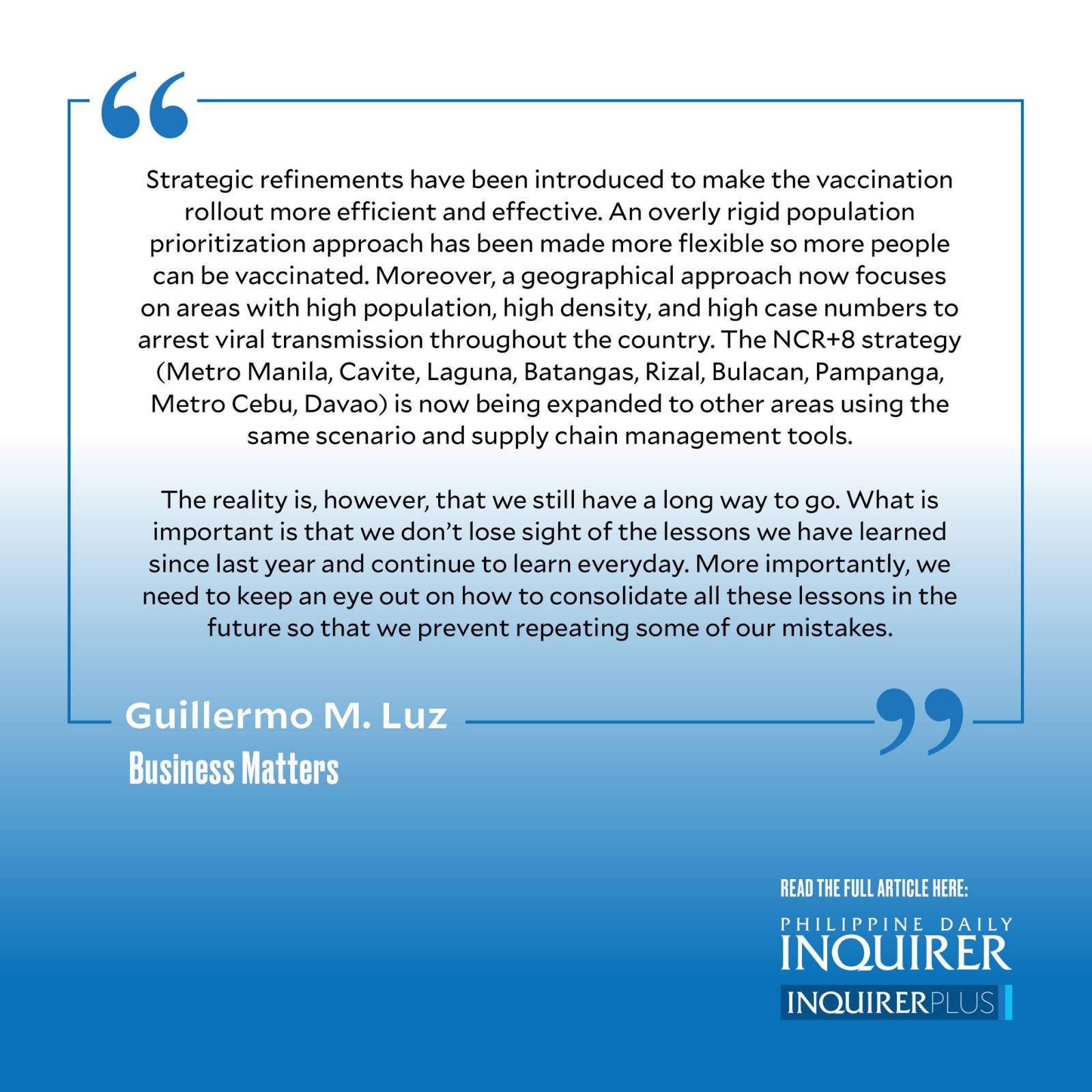COVID-19 and lessons past, present, and future

From time to time, I ask myself: “Knowing what we know now about the COVID-19 pandemic, what lessons have we learned?”
A first attempt at that reflection has now made its way to print in the recently published “Countering COVID-19: Cases in Crisis Response,” edited by Edilberto C. de Jesus, Manuel M. Dayrit, and Ivyrose S. Baysic. It’s a joint project of the Ateneo de Manila University Press together with the different Ateneo Graduate Schools of Medicine and Public Health, Business, Law, and Government. The book walks the reader through 21 chapters of the COVID-19 journey from different angles: local health systems, relief to recovery, the cost of its treatment and burden, transparency, governance, prospects of a better normal, economic responses, vaccination, and others.
I was honored to be invited to write one of the chapters. We started writing in the fourth quarter of 2020—neck-deep in the crisis, which is a little like trying to chronicle a moving target. It was a subject probably more appropriate for writing for a newspaper or a magazine rather than a book, which would not be printed until at least six months after the manuscripts were written and edited.
Nonetheless, the book captures the events and reflects upon the initial lessons learned at this early stage of the crisis. Though the picture is still incomplete and unfolding before our eyes, the book represents a good starting point to what I hope will eventually become a national reflection and soul-searching on how we should prepare for and respond to crisis.
In spite of many challenges, what I find encouraging is that the level of coordination and partnership between the national government, local governments, and the private sector has settled into a cadence and rhythm that is finally yielding some significant results.
For instance, when vaccinations first started on March 1, the key challenge was securing vaccine supply. We were off to a slow start, with only 3.5 million doses delivered in February and March, and roughly 1.5 million in April. The pace picked up considerably to 4.5 million in May and 9.2 million in June. We are expecting approximately 16 million in both July and August and an estimated 150 million-plus doses for the full year.
With deliveries flowing a little more smoothly, albeit with a few hiccups, we then set our sights on vaccination throughput. What use would vaccines be if we couldn’t get them jabbed into people’s arms? Together with supply chain and operations experts, targets were set based on city and provincial populations and scenarios were built around the number of vaccine centers, staffing, supplies, and productivity for cities to eventually vaccinate 70 percent of their population. Since putting this system in place, we have seen total vaccinations jump from 50,000 per day less than three months ago to about 230,000 per day. Peak performance has hit almost 350,000 vaccinations in a single day.
Strategic refinements have been introduced to make the vaccination rollout more efficient and effective. An overly rigid population prioritization approach has been made more flexible so more people can be vaccinated. Moreover, a geographical approach now focuses on areas with high population, high density, and high case numbers to arrest viral transmission throughout the country. The NCR+8 strategy (Metro Manila, Cavite, Laguna, Batangas, Rizal, Bulacan, Pampanga, Metro Cebu, Davao) is now being expanded to other areas using the same scenario and supply chain management tools.
The reality is, however, that we still have a long way to go. What is important is that we don’t lose sight of the lessons we have learned since last year and continue to learn everyday. More importantly, we need to keep an eye out on how to consolidate all these lessons in the future so that we prevent repeating some of our mistakes.
The Ateneo case book is a good starting point to ask ourselves: “If we are faced with a similar crisis in the future, what would we do differently?”
—————-
Guillermo M. Luz is chief resilience officer of the Philippine Disaster Resilience Foundation.
—————-
Business Matters is a project of the Makati Business Club (makatibusinessclub@mbc.com.ph).
For more news about the novel coronavirus click here.
What you need to know about Coronavirus.
For more information on COVID-19, call the DOH Hotline: (02) 86517800 local 1149/1150.
The Inquirer Foundation supports our healthcare frontliners and is still accepting cash donations to be deposited at Banco de Oro (BDO) current account #007960018860 or donate through PayMaya using this link.




















